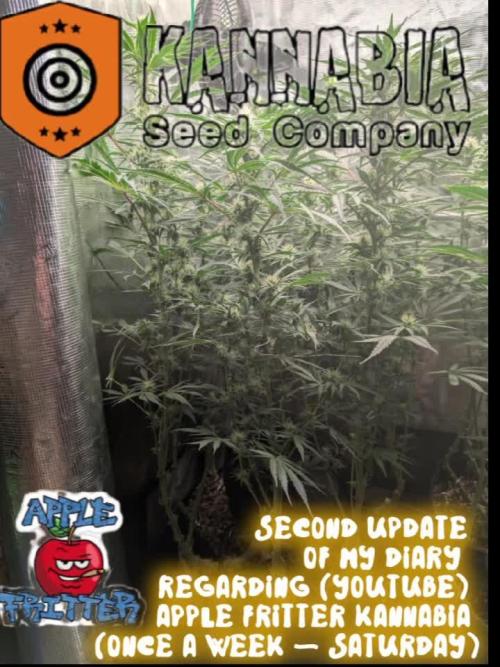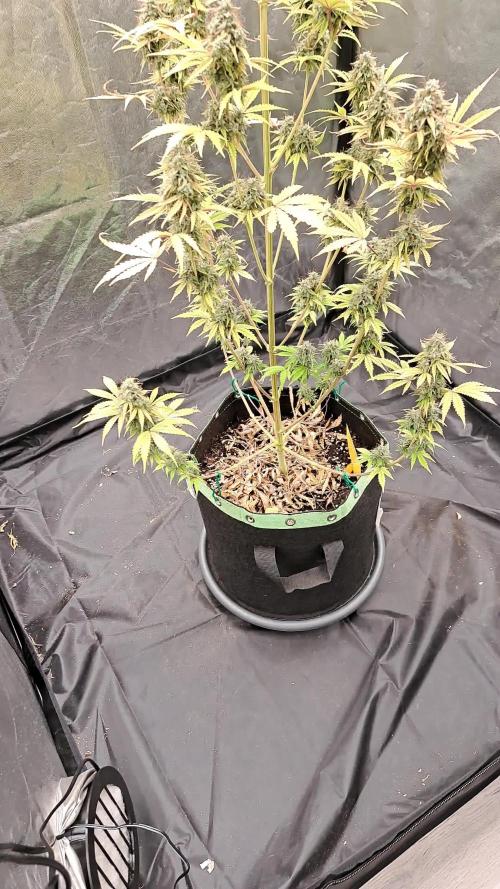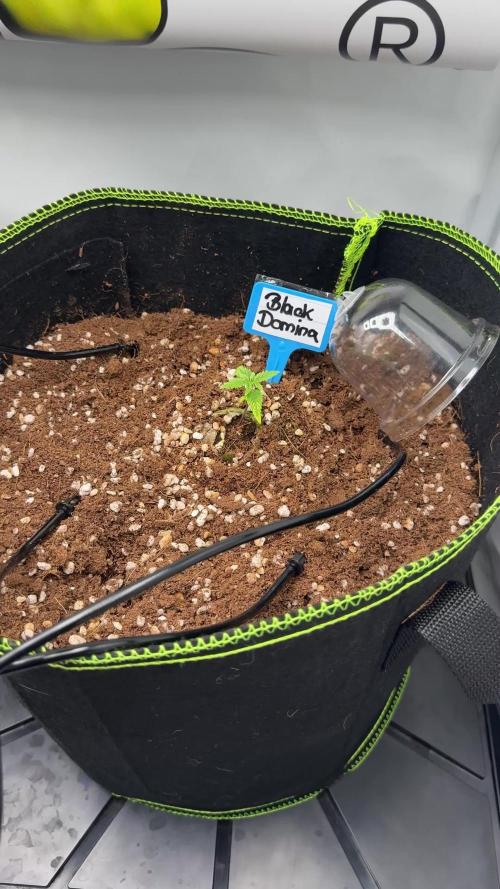The Grow Awards 2026 🏆 































Likes
Comments
Share


@musashi_miyamoto
Follow
Banana frosting still looks like shit. Just going to keep going and hope it gets better, again, not much I can do.
Mandarin punch is looking amazing. Giving about 200ml of water every 2-3 days, no nutrients in either pot. Going to start LST but not sure what to do or if it’s ready yet.
They get sunlight (through the window) from 8-12pm, then under the LED
Likes
9
Share


@treeofsong
Follow
My first soilless grow, i hope everything is gonna be alright
They got out 03/07/2018
I started watering 0,4 l per plant with 167 ppm on the 4th day from seed, i used 0,210 ml/L Floramicro; 0,420/L FLoraBlomm; 0,05 ml/L CAliMAGic
Likes
48
Share


@GReeNiNjaHashashiN
Follow
Stacking up on the sticky icky goo shimmering & glistening like she sparkled with glittering magic powder just beautiful...heres a video for ya'll enjoy.💚
Likes
417
Share


@yan402
Follow
🌸🍏✨🍭🌸🍏✨🍭🌸🍏✨🍭🌸
Hi and welcome to another Kannabia grow!
This time I’m running their Apple Fritter (feminized photoperiod). She’s going to veg under 24hr light and be manifolded.
Still cleaning the rest of my Candy Cream GF (11.04.25) — going to sow the seed tomorrow (12.04.25)
*been lazy, sowed on 14.04.25
🌸🍏✨🍭🌸🍏✨🍭🌸🍏✨🍭🌸
---
💭❗💭❗💭❗💭❗💭❗💭❗💭
❗Events & thoughts worth noting❗
💭❗💭❗💭❗💭❗💭❗💭❗💭
12.04.25 (GW1) – Cleaning + flushing the old coco coir. Might need to add another brick. *No new brick needed ✅
This is how I recycle my coco coir — fast, cheap, no BS.
🌿 Harvest plant
✂️ Chop roots small — they stay in for structure (organic perlite)
💦 Hot water rinse — remove salts & dust
🍶 Pre-soak with light feed:
Micro 10ml
Bloom 0ml
GreenBuzz 10ml
Cal-Mag 60ml
FFJ/FPJ 10ml (new disgusting batch)
pH down (citric acid)
♻️ Media stays — Roots stay — Back in service.
14.04.25 (GW1) – Planted seed in final pot ✅
16.04.25 (GW1) – Did last tent clean up + setup ✅📸
17.04.25 (GW1) – Seed germinated 🎉📸 — roughly 48hrs in final pot. Solid start👌♥️
23.04.25 (VW1) – Minimal burnt tips 📸 — not progressing, not a concern.
26.04.25 (VW1) – Started using the new batch of FPJ/FFJ
https://growdiaries.com/diaries/266849-grow-journal-by-yan402
30.04.25 (VW2) – Increased TriPartMicro & GreenBuzzBloom 10ml → 15ml
03.05.25 (VW2) – Increased TriPartMicro again 15ml → 20ml, topped the plant, and added final layer of clay pebbles around the base, trimmed side branches and did LST in preparation for "manifold" 📸
08.05.25 VW3 finished manifold📸
13.05.25 VW4 Increased TriPartMicro to 30ml and GreenBuzzBloom to 20ml.
15.05.25 VW4 Done defoliation and LST 📸
18-19.05.25 VW5 pruned all the shoots bellow my "mains" and did a full defoliation📸
24.05.25 VW6 increased GreenBuzzBloom to 30ml
04.06.25 VW7 did a cleanup📸
11.06.25 VW8 increase TriPartMicro to 40ml
17.06.25 (VW9) – Final structure pass 💈🌿
Did a clean perimeter prune + removed weak shoots. Ended up with 12 tops, was aiming for less, but she made the call
Didn’t fight it, just shaped it the best I could
Airflow’s good, structure’s stable
🛑 No more cuts until post-stretch
Pics coming shortly 😘
Flip coming soon — we’ll see how she handles it.
20.06.25 VW9 Switched lighting to 12 hours, may the stretch begin 🤞
22.06.25 VW10 Did a good LST session,made some pics, and came to some conclusions and a small change of plans:
Originally planned for 8 mains — long, spaced colas and maybe a couple stronger “titans” if she wanted to go that way.
But she’s showing me something else, and I’m not here to fight her — just guide her.
Now after stretch, I’m keeping side shoots only if they: Fill real canopy gaps
Don’t crowd neighboring tops (minimum 15cm spacing)
Aren’t growing into walls or toward the next plant
Anything too close, too low, or heading into shade gets removed. No point forcing it.
Looks like I’ll finish with 14–16 solid tops, depending on how she settles.
I’m just trying to give each one enough light and space to stack properly.
No overcrowding, no larf — just letting her do her thing with a bit of structure.
Increased Tri Part Micro to 50ml as well.
28.06.25 VW11 one week since I flipped to 12/12 and she is stretching nicely, a bit shy in showing pistils compared to the Fantasy Feast regulars I have in the same tent.
29.06.25 VW11 increased GreenBuzzBloom 30→ 60ml
06.07.25 FW1 TriPart Micro: 50→ 30ml
TriPart Bloom: 0 → 20ml
Home-made FFJ/FPJ (Watermelon + Pumpkin): 10 → 30ml
12.07.25 FW1 GreenBuzzBloom 60 →40ml, TriPart Bloom: 20 → 60ml, fpj 30→60ml
19.07.25 FW3 Got some bleached tops, been out and about at job interviews and didn't notice a last minute stretch spurt 😭, should recover fine though plenty of time left 😁
🌱💦🌱💦🌱💦🌱💦🌱💦🌱
🌿 Day to day tasks & actions 🌿
🌱💦🌱💦🌱💦🌱💦🌱💦🌱
19.07.25 FW2 – Fed 5l of #1 → 2l runoff
(*RUNOFF reused for tomato plants)
🍶💧🍶💧🍶💧🍶💧🍶
💧 Nutrients in 30L #1 – Week 11 Veg
🍶💧🍶💧🍶💧🍶💧🍶
💧 TriPart Micro: 10 → 15 → 20 → 30 → 40 → 50ml → 30ml (1.00ml/L)
🍶 TriPart Grow: 0ml (0.00ml/L)
💧 TriPart Bloom: 0 → 20 → 60ml (2.00ml/L)
🍶 GreenBuzz Bloom: 10 → 15 → 20 → 30 → 60→40ml (1.33ml/L)
💧 Cal-Mag: 60ml (2.00ml/L)
🍶 Home-made FFJ/FPJ (new batch): 10ml → 30→60ml (2.00ml/L)
💧 pH Down: Citric acid (buxXtrade)
📦 TOTAL: 250ml per 30L
🔬 8.33ml/L
🍶💧🍶💧🍶💧🍶💧🍶
⚙️✂️⚙️✂️⚙️✂️⚙️✂️⚙️
✂️ Tools & equipment ✂️
⚙️✂️⚙️✂️⚙️✂️⚙️✂️⚙️
✂️ 2× MarsHydro SP3000
⚙️ MarsHydro 150mm ACF Ventilator
✂️ Trotec dehumidifier (big unit)
⚙️ Mini no-name dehumidifier
✂️ Kebab skewers (LST – stainless)
⚙️ Wire + roast skewers (LST assist)
✂️ Scissors (HST)
⚙️ Vacuum (for spills & cleanup)
✂️⚙️✂️⚙️✂️⚙️⚙️✂️⚙️✂️⚙️✂️⚙️
---
🍏🍪🌬️🍬🍏🍪🌬️🍬🍏🍪🌬️🍬
Apple Fritter (Kannabia Seeds)
🍏🍪🌬️🍬🍏🍪🌬️🍬🍏🍪🌬️🍬
Species: 50% Indica / 50% Sativa
Genetics: Sour Apple × Animal Cookies
THC: Up to 25%
Effect: Euphoric, relaxing, creative
Flavor: Sweet, fruity, pastry notes
Flowering: 56–63 days
Resistance: High
Indoor yield: 450–500g/m²
Outdoor yield: 600g/plant
Structure: Strong, bushy, dense buds
Likes
1
Share


@Ogchemst
Follow
First day in Flower! It's been... very interesting 2 weeks.. now that I survived tha, im having some lockout due to being unable to take care of my plants for the past 5 days and someone having no idea had to do the job, I'm not afraid of showing these mistakes I'm always looking forward to the outcome so I'm still having some hopes for this og kush, not everything here went as planned and that's why I want to focus on finishing up the grow and starting new ones, better ones as soon as possible, I will definitely never grow autos again as I'm just not a fan of them having to be on 18/6 schedule and I like having co trolley over my plants as sometimes things can go wrong.
Og kush had a lockout after flush it grew beautiful but still ate up some of the upper leaves.
Runtz.. yeah I like him he is a beautiful little bonsai he didn't get lockout too much but also did I'm looking forward to seeting the stretch on him if it so happens.
Cherry gusher, a tiny pheno I got this time I'm looking forward to growing 4 next time and hunt down a pheno.
They say outdoors you have to play with God and indoor you try to play God.. we are not perfect and that's why I'm looking forward to the finish line.
Will i scrog? I have the net setup but I'm not sure if I will get enough stretch.
Day 3 I noticed some light white spots on bottom leaves of the plant after a flush I did recently, I diagnose this as magnese or magnesium deficiency, I'm going to up the cal mag to 8 ml and a+b to 10ml per 5 L of water along with additives extra 0.5 ml just as a touch up. Also I noticed we are at 47cm at the tallest branch after topping and lst and this thing is an absolute bush.. I could probably hide behind it if I was a kid playing hide and seek!.
Likes
10
Share


@Azazel420
Follow
Le piante aumentano di dimensioni giorno dopo giorno. Si comincia a sentire odore e i fiori si stanno riempendo di tricomi. Aggiungendo pk 13-14 ho visto un miglioramento della compattezza e delle dimensioni dei calici. Ho aumentato il fabbisogno nutrizionale perchè la.tipologia kush lo richiede.
Likes
82
Share


@WhiteEdge
Follow
23.04.2024
Continue into week 8
Replaced all filters in the system and cleaned them.
Mixed a new batch with the following components:
20+25ml AN Connoisseur Bloom A+B
Total volume: 34 liters
Electrical Conductivity (EC): 1.0
Target EC for this week: around 1.0. Adjustments will be based on plant observations.
Performed one long misting session (3 minutes).
Environmental Conditions:
Outside temperatures going up, today is raining but this week start higher temps and humidity
Wedding Cheesecake: One girl is gonna finish in this week, Two others probably in next. Frutti terps in this, Two pheno in total from 3 girls'
Tropicana Cookies: Phenomenal strain; One girl is going to finish this week and second couple days after . Two pheno in Tropicana's girls
Purple Lemonade: Tall plants, massive producer, all three girls will be in 9 week provably. Here so far all three girl share same characteristics and bud structure
Beautiful and high odor in the room!
Lighting Parameters: PAR Map: Maximum PPFD is 950, minimum PPFD is 650.
VPD: Ranges from -1.1 to -1.2.
Daytime Temperature (DT): 23-24°C.
Nighttime Temperature (NT): 19-20°C.
Leaf Temperature: 21-22°C.
Light Distance: 45-55 cm from the plants.
CO2 Levels: 700+ ppm.
HLG Scorpion Diablo: Set at 70%, positioned at a 45-55 cm distance.
Girls drink less water, so for this week and till the end of flowering new misting timing's
Daytime: ON for 70 seconds, followed by 30 minutes OFF.
Nighttime: OFF for 70 seconds, followed by 35 minutes OFF.
Nutrient Tank (NT):
pH: Maintained between 5.80 and 6.00. Stable PH, small drifting up and downs
EC: 1.05.
Temperature: 19-21°C
25.04.2024
TrolMaster toys arrived! Purchase new DST2E, DSP2E, DSH2E, AMP3+probes. Another DSH2E and DSP2E ordered to complete this grow box!
Replaced all filters in the system and cleaned them.
Mixed a new batch with the following components:
25+30ml AN Connoisseur Bloom A+B. Total volume: 17 liters
Electrical Conductivity (EC): 1.05
Tomorrow Tropicana Cookies harvest! Put bucket with this girl on separate line for flushing
Wedding Cheesecake also finish soon, probably in next week, Wednesday think...
Purple Lemonade still need full week or more...Exceptional odors
Temps and humidity otside start to raises, hope i will finish this run before Tropical heat
Lighting Parameters: PAR Map: Maximum PPFD is 950, minimum PPFD is 650.
VPD: Ranges from -1.0 to -1.1.
Daytime Temperature (DT): 23-24°C.
Nighttime Temperature (NT): 19-20°C.
Leaf Temperature: 21-22°C.
Light Distance: 45-55 cm from the plants.
CO2 Levels: 700+ ppm.
HLG Scorpion Diablo: Set at 70%, positioned at a 45-55 cm distance.
Daytime: ON for 70 seconds, followed by 30 minutes OFF.
Nighttime: OFF for 70 seconds, followed by 35 minutes OFF.
Nutrient Tank (NT):
pH: Maintained between 5.80 and 5.95. Stable PH...
EC: 1.05.
Temperature: 19-21°C
26.04.2024
Connect TrolMaster components into the Tent-X system. Program DSP2E, Temperature DST2E, Humidity DSH2E, as well as the AMP3 sensor with PH and EC probes, are all in place.
After calibrating the probes, AMP3 module works perfectly! It has a quick response in measurements, is accurate, and I am very happy about the possibility of online monitoring of liquid values.
After day off use i can tell that all readings are very consistent, compared with Milwaukee, totally without all over the place measurements. Perfectly steady and on spot receding!
The Program device runs flawlessly all day, and I hope it has solved all the problems I had with DH48-S timers.
The humidity control operates without errors throughout the day, and it’s nice to see in the app when the module is active.
Raise light as much as i can..50-55cm from canopy. Set off misting time from 30min to 35min @ day time , and from 35min to 45min @ night time
Flush Tropicana Cookies' for one more day, tomorrow harvest, prepared tent for drying with humidifier , ventilation and temperature and humidity controllers
PAR Map: Maximum PPFD is 850, minimum PPFD is 500.
VPD: Ranges from 1.0 to 1.1.
Daytime Temperature (DT): 23-24°C.
Nighttime Temperature (NT): 19-20°C.
Leaf Temperature: 21-22°C.
Light Distance: 45-55 cm from the plants.
CO2 Levels: 700+ ppm.
HLG Scorpion Diablo: Set at 65%, positioned at a 50-55 cm distance.
Daytime: ON for 70 seconds, followed by 35 minutes OFF.
Nighttime: OFF for 70 seconds, followed by 45 minutes OFF.
Nutrient Tank (NT):
pH: Maintained between 5.80 and 5.95. Stable PH...
EC: 1.05.
Temperature: 19-21°C
28.04.2024
First harvest in this run! Tropicana Cookies No1 is a winner.) First Tropicana Cookies is harvested on 89 day from seed. Total 55 days off flowering.
Fast flowering indeed as fast in vegetative stage. Cut this girl in branches and hang upside-down in smaller tent for drying
Set RH @ 55% , temperatures not able to control so they will be something around 20-21 in drying tent
Second Tropicana will be chopped within a couple off days. Checking trichomes with microscopes can tell that one Purple Lemonade is also going to finish in next days
Somme lady's will take full 9 weeks or so..
Lowering light intensity, EC in tank start to raise slowly so i will start to adjust according to condition. Currently 0.85EC is perfect strength i think
PAR Map: Maximum PPFD is 850, minimum PPFD is 550.
VPD: Ranges from - 0.9-1.0
Daytime Temperature (DT): 23-24°C.
Nighttime Temperature (NT): 19-20°C.
Leaf Temperature: 21-22°C.
Light Distance: 45-55 cm from the plants.
CO2 Levels: 700+ ppm.
HLG Scorpion Diablo: Set at 65%, positioned at a 45-55 cm distance.
Daytime: ON for 60 seconds, followed by 30 minutes OFF.
Nighttime: OFF for 60 seconds, followed by 35 minutes OFF.
Nutrient Tank (NT):
pH: Maintained between 5.80 and 5.95. Stable PH...
EC: 0.85.
Temperature: 19-21°C
Week 8 off Flowering in Summary
80 litter off RO water,
120ml+150ml AN connoisseur A+B
45kW electricity in total for light, Pumps and AC Infinity Fans. 42kW for Light + 2kW Dehumidification + AC Infinity ventilation
Week start @ 1.1EC, nutrient strength., week finish with 0,87EC
Tropicana Cookies is first harvested on day 89 from sprouting , week 8 off flowering
Purple Lemonade is going to be on second place with harvest on day 91, last day off 8 week off flowering
PH was stabile and move from 5.70 min to 5,9 max.
Light distance for this week - 50-55cm from tallest top , PPFD levels around 900 in center, trough whole week. Lowest reading 500 @ corner
Temperature are from 20c at start off day to 24.5c max at some points.
Night temps around 19.5-20c. Outside humidity is generally low
This week i have install TrolMaster AMP3 sensor and humidity, temp and program devices
Day RH is moved from 45% to 55% max, at night times drop to 45-48%
Lighting Parameters: PAR Map: Maximum PPFD is 900, minimum PPFD is 650.
VPD: Ranges from -1.0-1.1.
Daytime Temperature (DT): 24.5°C.
Nighttime Temperature (NT): 20°C.
Leaf Temperature: 22°C.
Light Distance: 45-55 cm from the plants.
CO2 Levels: 700+ ppm.
HLG Scorpion Diablo: Set at 65%, positioned at a 45-55 cm distance.
Daytime: ON for 70 seconds, followed by 25 minutes OFF.
Nighttime: OFF for 70 seconds, followed by 35 minutes OFF.
Nutrient Tank (NT):
pH: Maintained between 5.8 and 6.1
EC: 0.87-1,1.
Temperature: 20-21°C
Processing
Likes
42
Share


@Teamdirtbag3
Follow
Done..... 19 plants
Tangerine Skunk I love this pheno 🤩
🍊🔥🍊🔥🍊🔥🍊🔥🍊🔥🍊🔥🍊🔥
😈
Likes
26
Share


@Growdaddy420
Follow
Grow is going exceptionally well now.
Calmag Lockout fixed with new white hairs dailyane noticable bud growth.
The amnesia auto is getting close to harvest, going to give it another week. Tricombs are mostly cloudy few clear. I believe it's around day 73 from planting.
The smell of the Jack plants is overwhelming. That strong destinctive piney smell. Ben a minute since I smoked some Jack, looking forward to it.
Check out the video too stoned to take good pics, it gives a better perspective.
Cheers,
Growdaddy
Likes
5
Share


@chimichurra
Follow
19 de Abril: Poda de bajos y cambio de fotoperiodo a 12/12
22 de Abril: Riego con calcio, es algo que no tengo super probado, pero viene dando muy buenos resultados. Las próximas semanas se aplica foliar.
23 de Abril: Pulverizado de hechizo bloom, es una fuente de nutrientes y micro vida, también hace de bioestimulante. Las primeras 4 semanas de flora se pulveriza, el resto de semanas se usa en riego.
25 de Abril: Riego con BioAtomic, un bioestimulante biomineral que me ha dado buenos resultados, y quería terminar el frasco. Esta es la última aplicación que voy a hacer.
Además agregamos la segunda malla scrog, aunque todavía solo llegan pocas ramas.
En los 5 días que lleva de flora las plantas pegaron un buen estirón, pero sin descontrolarse, creo que no voy a tener problemas por ese lado. Las plantas se ven super sanas y creciendo relativamente parejo.
Tema aparte, sumé una automática en el fondo de la carpa a la derecha. estuvo 6 semanas en exterior y nunca floreció, ni se la ve muy bien. Hablé con el proveedor y dice que es un problema de fertilización y luz, no de estabilización de la semilla, yo opino lo contrario, las hojas vienen saliendo deformes y nunca vi una autofloreciente vegetar 6 semanas sin indicios de preflora. La metí al indoor para ver qué ocurre, y si tengo razón, servirá como prueba para que me repongan la semilla. La voy a seguir fertilizando con short flowering de green house feeding. Les voy air contando que ocurre también con esta planta, y más adelante voy a hacer un seguimiento con las otras autoflorecientes que todavía no germiné.
Likes
134
Share


@BigDaddyK
Follow
I will try and update daily
Germination requires 3 things - Darkness , Warmth , Water
One thing i should mention - Growing autoflowers, is difficult to do well,why? because from the moment that seed sprouts, you have a finite amount of time before she is finished, so any fucking about with anything ( repotting,pests,nutrient issues) , will lower yield.You can sometimes get them finished in 10 weeks on 20/4 but unless you have a controlled environment its hard to go more than 18/6 without heat and humidity issues.Autoflower breeding has come a long way in the last 10 years,Fast Buds is one of the pioneers.
Day 1 - Tuesday 16/10/18
Put into wet root it cubes , then into the net pots with the clay pebbles, then pots into my rooting dwc boxes , placed a dome over the top to increase the humidity .
Day 2 - Weds , nothing happening yet !
Day 3 - Thursday , I think she has popped , not quite up yet , see pink picture
Turned light on 17/7 , why ? because I think this is best @ 13-15,000 lux
Bestva 800 (150 watt draw) Led approx £100 , I would buy the dimable cob version if you can .(900 or 1200)
Day 4 - Friday , looks a little distorted , has she got three leaves ? night time took a pic on the G7 ....
Day 5 - Saturday , definitely three leaves , might just be the first node , fingers crossed she will be fine , was quite worried she wouldn’t make it , gave her 20 ml of room temperature water , with a syringe onto the root it cube ,
Day 6 - Sunday , looking ok , nice and green , I’m hoping the roots will be into the reservoir by now , you have to love fast buds , the germination rates are almost 100% , I have included a picture with the rest of the pots , for reference , there is a gorilla glue and a tangiematic, two of my favourite Fast Buds strains , which I started around the same time ,
IMPORTANT- do no let the root it cubes dry out before the roots are into the reservoir , make sure the bottom of the net pot DOES NOT touch the water
Day 7 - Monday , I checked the water level and the ph , it has lost a little due to evaporation , root is well into the reservoir , I will add some nutrients tomorrow, seed on top right has pushed up but no leaves, this is NOT a fast buds seed, just shows u,... i have also put more pebbles in to cover up the holes, it would be nice if they did a pot that didnt have holes all the way to the top !!!
Building DWC - you can build a DWC quite easily , out of cheap items , the ones in this week , were made by a friend of mine (Kev) when he spotted the box at Poundland for £1 - all you need is a black plastic box ( black so no light penetrates the roots ) with a lid , a 127mm hole cutter , air pump with tube and air stone , 140mm net pots to go in holes , some clay pebbles , and root it cubes , I will make a little instructional video , the reason I put them in here is because I will transfer into my IWS oxypots , which are too big to go into the tent ,and as the led is better with small plants it’s much easier .
Processing
Likes
15
Share


@eldruida_lamota
Follow
Que pasa familia, hoy actualizo la ... no se que semana será de floración pero ahí están, engordando, no veas que céntrales que tuesta tirando, son cohetes.
El ph, lo estamos controlando en 6,2
La humedad está en 35% y la temperatura oscila los 29 grados encendido y 22 apagado.
Os confirmo a que este y los últimos 2 diarios activos serán con advanced nutrients.
Y a partir de ahora los próximos proyectos aportaremos la alimentación de la casa agrobeta. Y nos centraremos más en una buena tabla de alimentación para las futuras niñas ( en mi instragram @eldruida_lamota ) tenéis un post con todos los productos a utilizar en todo el proceso de crecimiento y floración.
Volviendo a las crazy cookies, estamos en su recta final, osciló que como mucho 2 semanas más pero ya veremos cómo avanzan, llevan sin alimento unas semanas también y empieza a notarse en la falta de alimento. Pero ya solo agua, estrés hídrico cada riego menos cantidad de agua , las raíces abajo mueren , termina chupando el alimento por la parte superior de las raíces y ese estrés genera que la planta siga escupiendo tricomas.
Esto es todo por ahora , la próxima semana actualizamos todo fumetillas.
Likes
9
Share


@SeseGrows
Follow
Home Interior 90x90//
Do Si Dos 33 - Granja Barneys + Sour Diesel + Roadawg
//Semana 4//FLORACIÓN
- Grotek Nutrients.
- Lumatek LEC 315w+ 💎 .
LEC 315w —> 100%
Likes
4
Share


@CanarianGrow92
Follow
Week 2 vegetation for the Apricot from fastbuds 420.
All good at the moment, we are testing the xpert line with these girls.
1ml of master grow A+B
1ml of master root
We removed the 2 lowest sets of leaves and branches. We do this because we have the girls in 7 liters and quite some plants together, so i prefer to concentrate on the main bud and only some side buds
Likes
2
Share


@Sebb_growt
Follow
Die letzte Woche steht der Dame bevor, nächstes Wochenende wird geerntet.
Damit ist dann auch der Automatic grow abgeschlossen und es kommen über den Winter neue photo's ins Zelt.
Processing
Likes
10
Share


@Dunk_Junk
Follow
9cm growth this week.
She is very short, very bushy. Not sure what I've done wrong... 😞





















